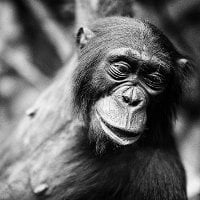 Back in 1960, when world-renowned primate expert Dr. Jane Goodall observed that chimpanzees make tools to dig for termites, she debunked the belief that only humans can make tools—even if mainstream science was unwilling to accept her finding back then. Today, however, a steady flow of studies proves just how smart animals are, and primatologists, including Frans de Waal, are singing a different tune about animal intelligence.
Back in 1960, when world-renowned primate expert Dr. Jane Goodall observed that chimpanzees make tools to dig for termites, she debunked the belief that only humans can make tools—even if mainstream science was unwilling to accept her finding back then. Today, however, a steady flow of studies proves just how smart animals are, and primatologists, including Frans de Waal, are singing a different tune about animal intelligence.
In his recent book, Are We Smart Enough to Know How Smart Animals Are?, de Waal refreshingly asserts that since humans are animals, human cognition is a type of animal cognition, not the other way around. It follows, then, that animals deserve the same rights as humans—to be protected from harm and exploitation and treated as sensitive, intelligent individuals.
Animal rights advocates have long praised animals for their intellectual and emotional aptitude, and humans have increasingly recognized the complexity of animal cognition. Just look at how many videos of animals doing fascinating things consistently dominate the internet. Examples of animal intelligence documented by scientists are equally entertaining: Octopuses can learn to open medicine bottles with childproof caps that some humans can’t manage, cows clearly understand cause-and-effect relationships, and dogs and horses can recognize body-language cues that humans miss.
The latest evidence for animal cognition to catch the scientific community’s attention is that chimpanzees can do almost everything that scientists once considered an exclusively human trait. Notably, chimpanzees—who share 99 percent of their DNA with humans—can make tools, as Dr. Goodall observed 57 years ago. And some of these tools are quite sophisticated.
In Gabon, humans have repeatedly seen chimpanzees trying to locate honey while equipped with five different tools: a stick to break a hive open, another to puncture the honey chamber, another to enlarge the opening, one with a frayed end to dip in the honey, and strips of bark to scoop the honey up. Chimpanzees in the Congo have repeatedly been observed traveling with two sticks—one thin and flexible and the other a meter long—which they use to dig into nests and capture ants. Communities of chimpanzees typically use between 15 and 25 tools, which are often prepared in advance with techniques passed down from older generations.



As we’ve learned more about our animal kin, other “human-exclusive” trait theories have been debunked. Sheep recognize faces, squirrels exhibit self-control, mice and pigeons display empathy, rats show regret, dolphins and elephants can identify themselves in mirrors, fish can count up to four, and dogs can remember distant events and possess a human-like sense of morality.
The more that humans acknowledge how intelligent other animals are, the less likely they’ll be to harm them. So learn all you can about this fascinating and important subject—and the next time you order food out, go shopping, or buy tickets to a show, make choices that are kind to all living beings.
Written by Kimberly Walls




